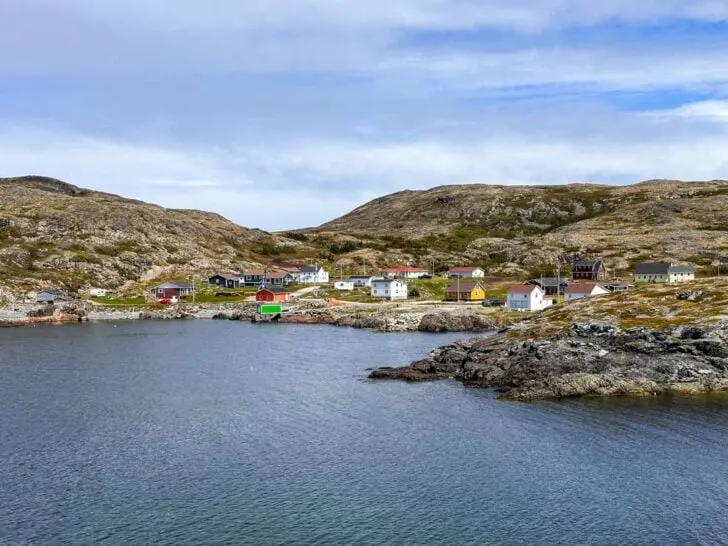Fogo Island is a bit mysterious. It’s a small island off the coast of Newfoundland with a stunning windswept landscape and a tight-knit community. I dreamed of visiting for nearly two decades, and recently, I made it happen. There are so many cool things to do on Fogo Island!
If you’ve never heard of Fogo, read on. This place is so beautiful and unique. But if you’ve heard of it, it’s likely for one of two reasons. Firstly, it’s featured prominently in the chorus of the Newfoundland folk song “I’se the By'”. (The lyric is “Fogo, Twillingate, Moreton’s Harbour, All around the circle.” I couldn’t stop singing it when I was there.
The other reason is that a social enterprise organization built a new luxury hotel called the Fogo Island Inn. It’s been in the news for attracting celebrity guests like David Letterman, Gwyneth Paltrow, and Canadian Prime Minister Justin Trudeau.
If you’ve read any recent press about Fogo, they make it sound like the hotel is the main attraction and you must be rich to visit. As a regular person, I wasn’t sure about visiting Fogo. Would there be anything for me to do?
After visiting I can tell you that anyone can visit Fogo and have a great time, even those on a regular person budget! There are lots of guest houses and restaurants catering to independent travellers. And most of the things to do on Fogo Island (like hiking and the museums) are free or cheap!
I’ve put together a complete guide to things to do on Fogo Island, Newfoundland. It includes:
- Fogo Island Basics: How to get there? How long to spend? Best time to go?
- Map of Fogo Island that includes all of the places I mention in this post.
- Best things to do on Fogo Island: Cute towns, hiking, an iconic hotel, history, and lots more.
- Where to eat on Fogo Island: My picks for the best restaurants.
- Where to stay on Fogo Island from basic campsites to luxury hotels and everything in between.
Planning a trip to Newfoundland? I’ve got a big list of the best things to do Newfoundland plus lots of travel tips for the province.
This is a sensitive wilderness area. Learn how to Leave No Trace to keep the wilderness wild. Make sure you are prepared by bringing the 10 Essentials. Get ready for adventure with this checklist of things to do before every hike.
Hey there: Some of the links in this post are affiliate links, which means I earn a small commission at no cost to you. Thanks for your support. -Taryn
Fogo Island Basics
How to Get to Fogo Island
Fogo Island is located off the north coast of central Newfoundland. Depending on your budget and timeline, there are several ways to get there.
I took the slowest and cheapest route – driving and the ferry. The ferry terminal in Farewell is one hour from Gander, 3.5 hours from Deer Lake, and 4.5 hours from St. John’s, all of which have airports if you’re flying into Newfoundland. If you’re already in Newfoundland on a road trip like I was, the ferry terminal is 1 hour from Twillingate, which is worth visiting before or after Fogo.
You cannot reserve the ferry so it’s best to show up early. Check the ferry schedule for the latest times. On busy summer days, there can be multiple sailing waits. There are two ferries from Farewell to Fogo Island. The direct ferry takes 45 minutes. There is also a ferry that stops on the sleepy Change Islands which takes 1 hour and 15 minutes.
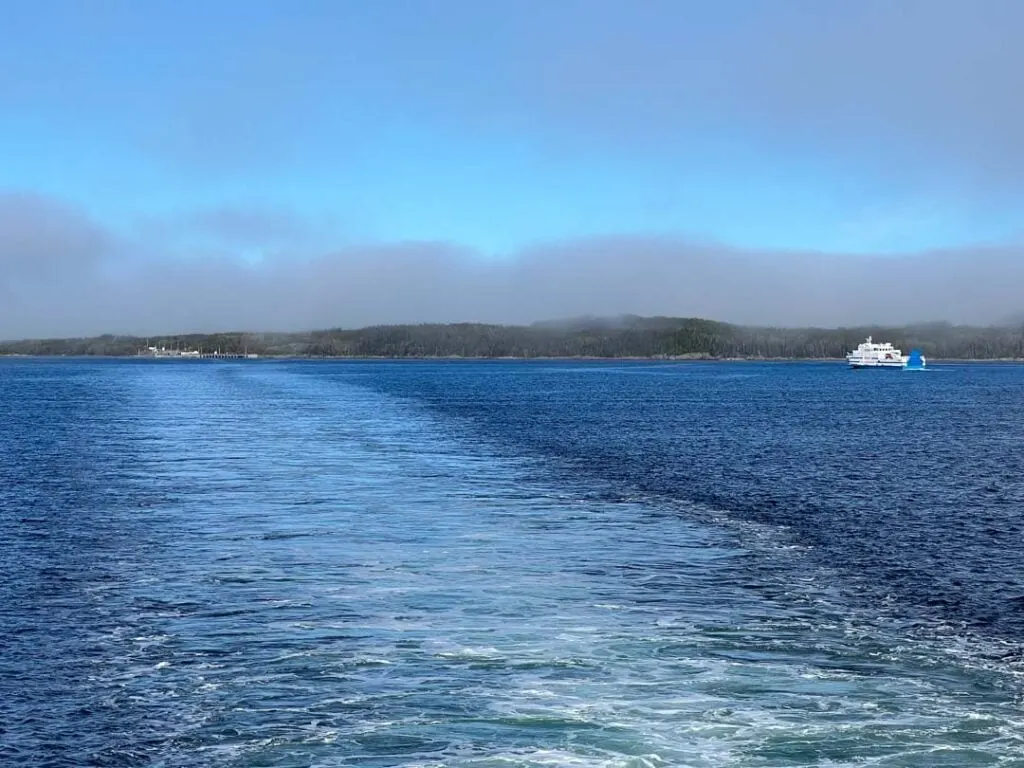
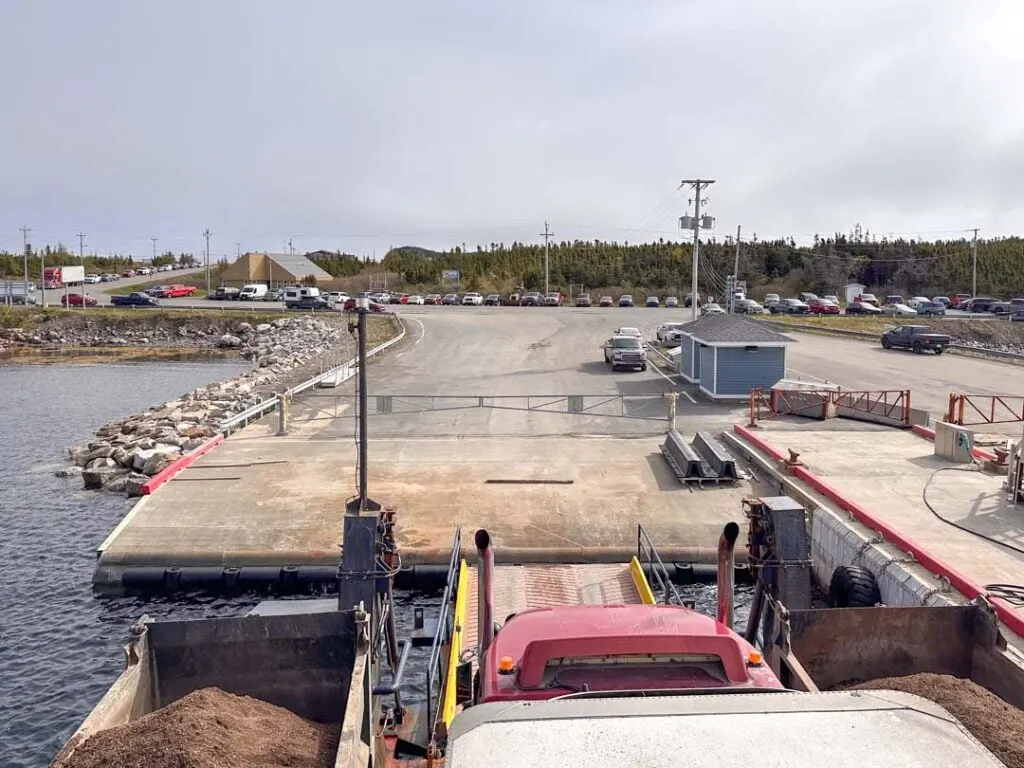
Once on the ferry you must leave your car and go upstairs to the lounge. On a nice day, you can enjoy the view from the outer decks. But if the weather isn’t great, bring a book.
If you’re looking for a fast and expensive way to get to Fogo Island, you can book a charter plane or helicopter from Gander or St. John’s. If you’re staying at the Fogo Island Inn their staff can help you arrange flights.
Getting Around on Fogo Island
Fogo Island isn’t big. But it’s not tiny either. The island has nine villages and is about 25 km long by 14 km wide (16 x 8.7 mi) so you will need a car to get around. If you drove all the roads on the island it would take you about 90 minutes.
Cell Service on Fogo Island
Cell service is pretty spotty on Fogo Island. You won’t get 5G anywhere on the island. There is LTE in most of the towns, but many areas have little to no service. I recommend downloading offline maps before you go. If the visitor centre near the ferry terminal is open, they also have paper maps.
Money and Banking on Fogo
Fogo Island is isolated and doesn’t have a bank. All the businesses we encountered take credit and debit cards. We also saw a few businesses with signs saying that they don’t take cash since they have to go off-island to deposit it and it’s too time-consuming and expensive. Expect to pay with cards on Fogo.
How Long to Spend on Fogo Island
If you get the first ferry to the island and the last one off, it’s possible to do Fogo Island as a day trip. But I recommend spending at least one night on Fogo Island. Doing it as a day trip will be quite rushed and since you can’t reserve the ferry, you’ll have to line up quite early to make sure you don’t miss the last boat.
I spent one night on Fogo and honestly, I wished I had spent a second night. It’s such an interesting place with a vibe that is like nowhere else in Newfoundland. Spending an extra day would have allowed us to do some more hiking and also would have made our time on Fogo a bit more chill. And Fogo is definitely a place to slow down and take it all in.
Best Time to Go to Fogo Island
At the Fogo Island Inn they argue that Fogo has seven seasons: winter (December to February), pack ice (March), spring (April to mid-May), trap berth (mid-May to June), summer (July and August), berry (September to mid-October), and late fall (mid-October to November). If you stay at the Inn, they will organize activities for you at any time of the year.
But if you are travelling independently like I was, the best time to visit is July and August. That’s the time of the year with the best weather. It’s also when you will find most businesses and museums open. June and September can also be good, but will have more variable weather. As well, some businesses and museums will be closed.
Check the opening hours of key attractions. Fogo is small and some businesses don’t open until early June or July and shut in early September. As well, some are closed a few days a week even in the height of summer. Some places have opening hours posted online, but for others, you’ll just have to go check in person.
Fogo Island Weather
Summer might have the best weather on Fogo Island, but this isn’t the tropics! You are still on a windy island in the Atlantic Ocean! Bring a rain jacket and a fleece or puffy jacket for warmth, just in case.
In June, July, and August, temperatures are usually between 10 and 20°C (50 to 68°F). Fogo Island is windy and doesn’t have very many trees, so it can feel much colder than the thermometer might indicate.
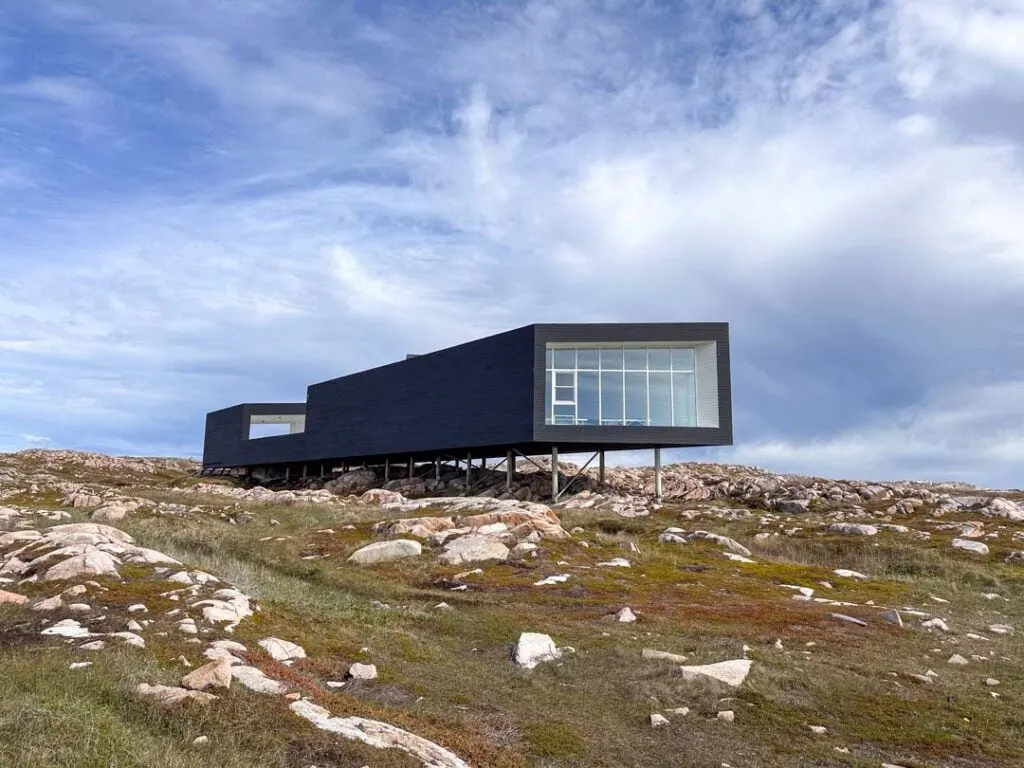
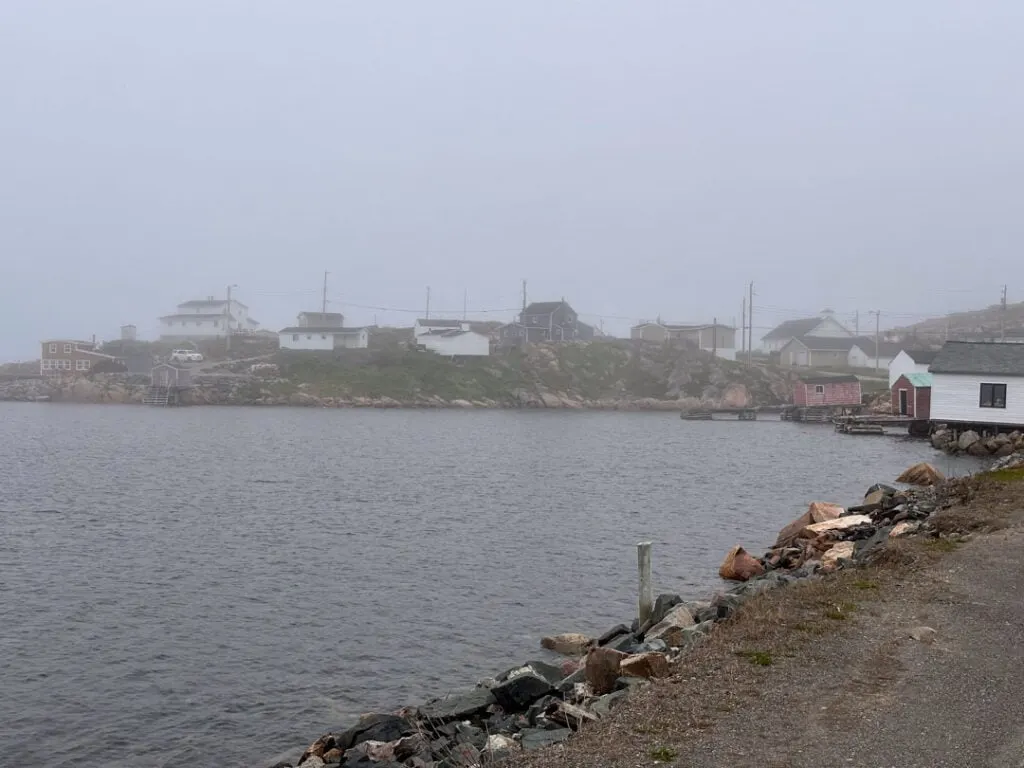
History of Fogo Island
Like the rest of Newfoundland, Fogo Island is the traditional territory of the Beothuk and Mi’kma’ki.
The name of the island means fire in Portuguese and it likely got its name from the cooking fires of Indigenous people that European fishermen spotted from their boats.
The first European settlers on Fogo were mostly from England, although the village of Tilting is the oldest Irish settlement in North America. The settlers were mostly fishermen who needed a place on land to dry their cod.
Over the years mercantile companies in St. John’s monopolized the cod fishery. The people of Fogo Island fought back by forming the Fishermen’s Protective Union in the early 1900s to sell their fish as a cooperative and gain control of their livelihoods.
In the 1950s and 60s, the newly-formed provincial government of Newfoundland started a resettlement scheme to consolidate far-flung water-access-only fishing villages into larger towns with more reliable road transportation and better community services. The Fogo Islanders developed a collaborative community consultation program called the Fogo Process to decide whether to accept resettlement. In the end, the islanders decided to stay.
When the cod moratorium came into effect in 1992, the economy of Fogo Island was devastated. In 2006 Zita Cobb, a tech millionaire who grew up on Fogo, started the Shorefast Foundation. It’s a social enterprise designed to revitalize Fogo Island’s economy through tourism and the arts. The famous Fogo Island Inn is part of Shorefast.
Today Fogo Island has about 2,100 residents. While locals still fish, today the economy revolves more around tourism, much of which comes in the form of wealthy guests staying at the Fogo Island Inn. However, the island’s isolation means that it doesn’t feel touristy or busy.
Fogo Island Map
To help you find your way around, I made this custom Google Map of Fogo Island for you. It includes every single place I mention in this post.
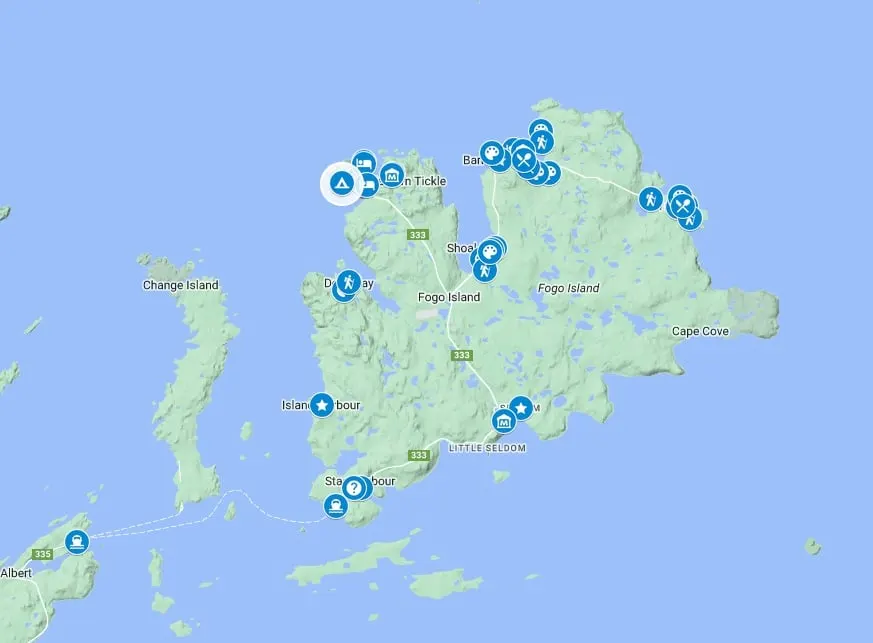
Best Things To Do on Fogo Island
Take a Tour of Fogo Island Inn
The Fogo Island Inn is a luxury hotel catering to wealthy guests who often fly in from all over the world. They have a three-night minimum stay and in the summer rooms start at about $3000 per night. It’s all-inclusive, so that price includes gourmet meals and activities like yoga, hiking, and boat tours.
If, like me, the Fogo Island Inn is not in your budget, it’s worth visiting on a tour. It’s an iconic building with stunning architecture and so much attention to detail. The only way for non-guests is to call ahead and arrange for a tour. There are usually two tours and day and they are free. There isn’t any info on their website about tours but if you call them, the front desk can help you out.

We had a great tour with a local woman who grew up on Fogo in the 1960s and told us all about what Fogo was like when it was an isolated fishing community. She also did a great job of showing us all the ways that the hotel is designed to reflect the local Newfoundland and Fogo Island culture, right down to the designs of the wallpaper and the furniture.


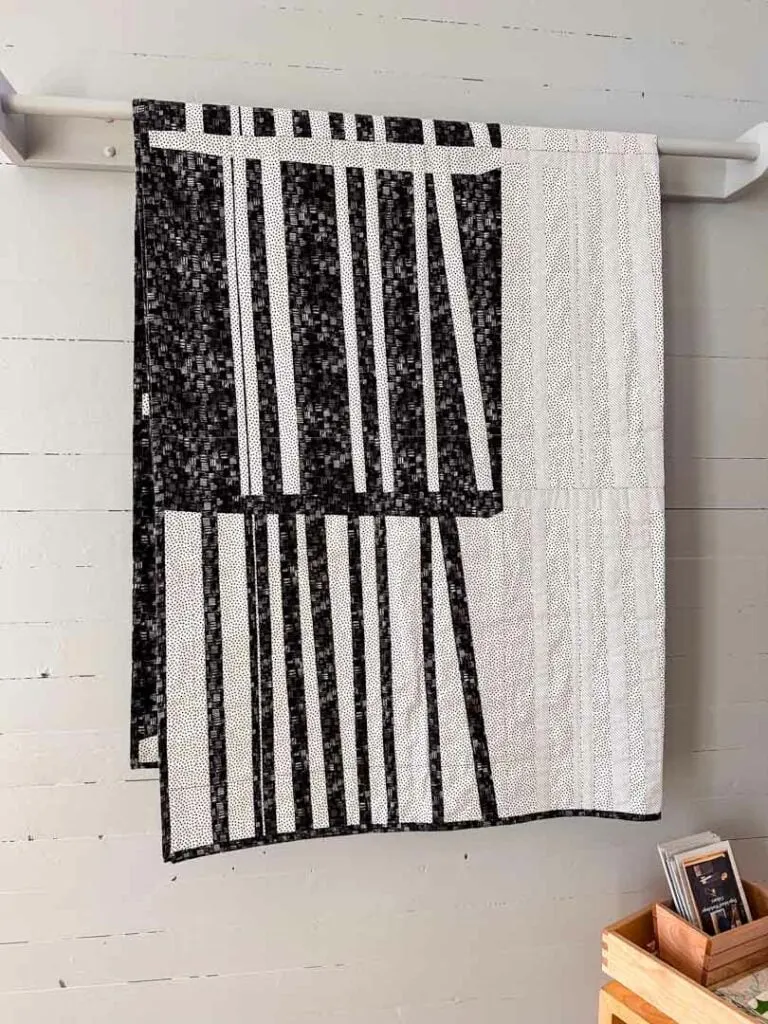
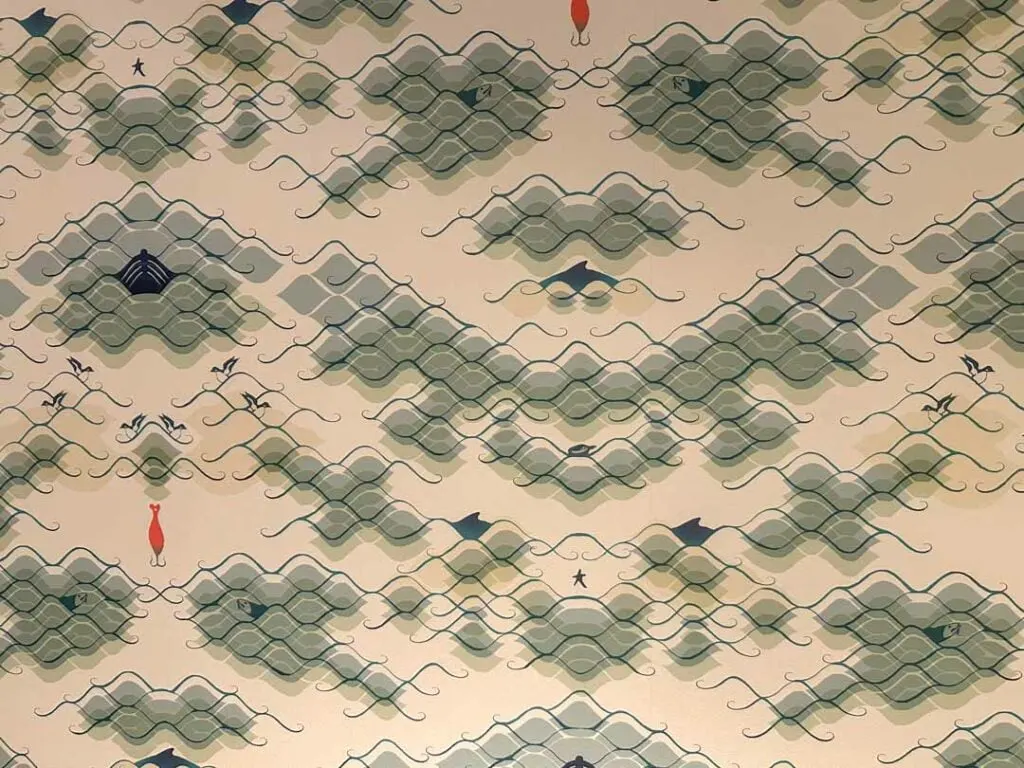

Since the inn relies on such an upscale clientele (and uses that business model to bring maximum economic benefit to the community), I will say that the tour had a bit of a strange vibe. As tour participants, we weren’t allowed into any area where guests were and the whole thing had a weird, “don’t-make-eye-contact-with-the-rich-people” atomosphere. But the inn was beautiful and the tour was free so I’m glad I went.
Learn About Irish History in Tilting
The village of Tilting at the east end of Fogo Island is one of the oldest Irish settlements in Newfoundland, first settled in the 1780s. Today it is a Newfoundland Registered Heritage District and National Historic Site of Canada with lots of historic buildings.
The locals are proud of their history and it seems like every fifth building has a historical plaque out front with info about its history. Several of the buildings, including the Dwyer Premises and Lane House, are museums with exhibits inside. However, they are only open in July and August so I wasn’t able to see them on my June visit.
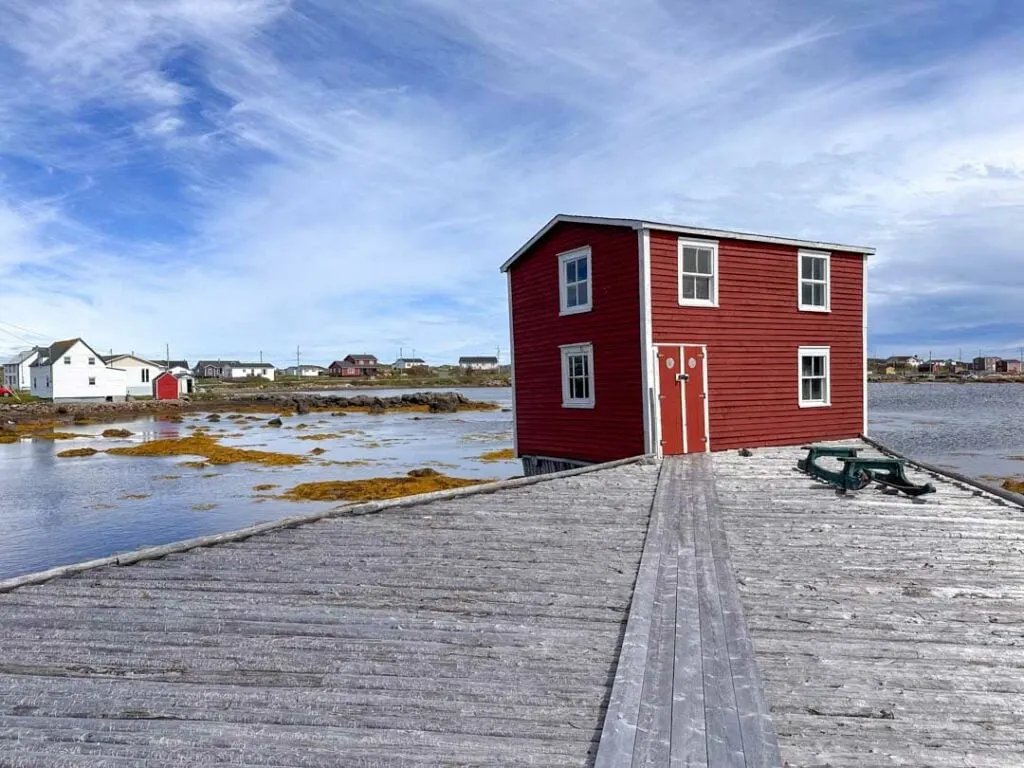
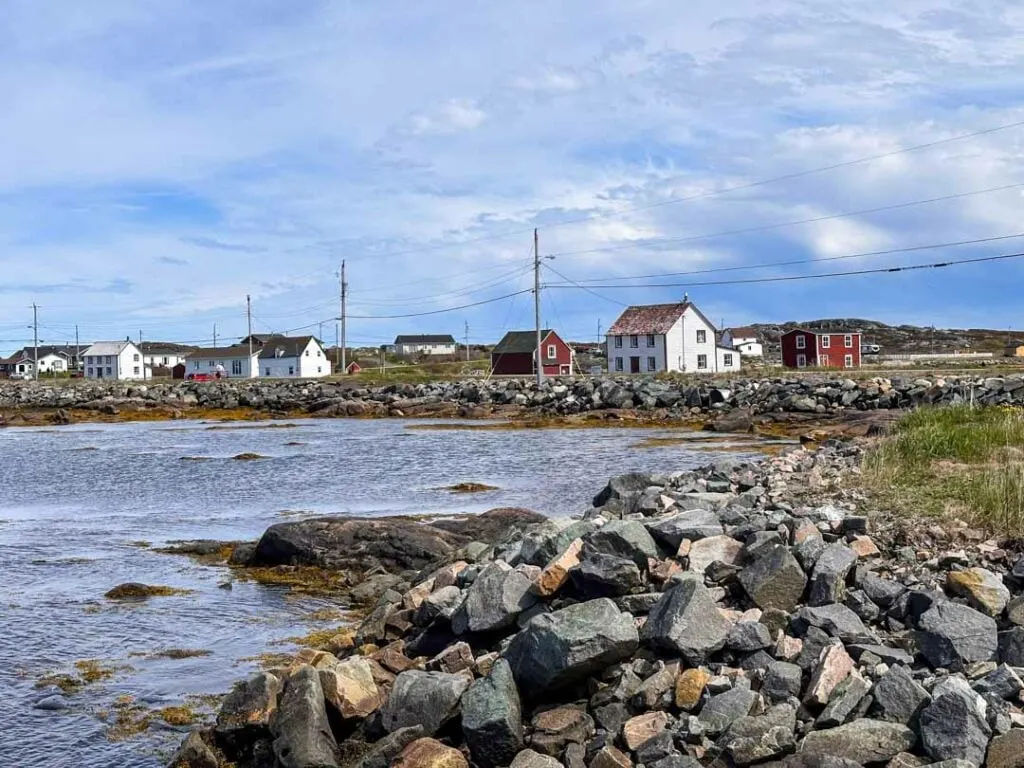
I’ve also heard great things about Al’s Walking Tours in Tilting. Unfortunately, we weren’t able to take his tour because it conflicted with the time of our Fogo Island Inn tour. Next time!
Find the Artists’ Studios
Fogo Island Arts supports an artists’ residency program on Fogo Island where artists can come to work at one of four custom-built studios. Stumbling across these studios was one of my favourite parts of my visit to Fogo Island. Each one is strangely beautiful and interplays with the landscape.
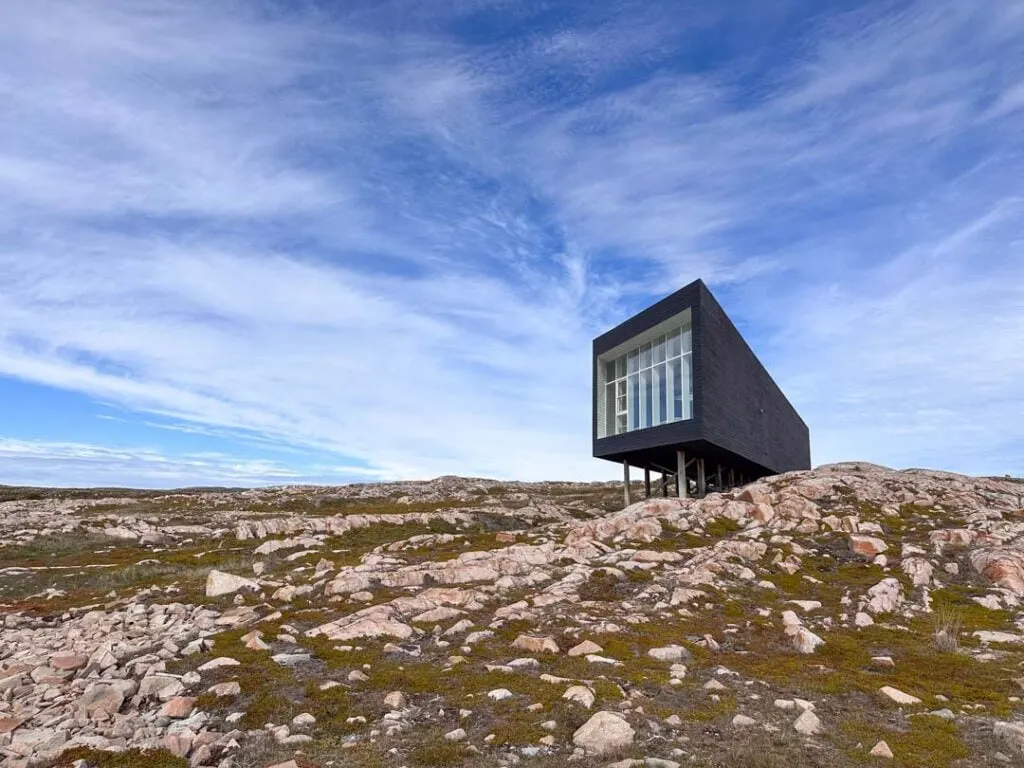
The only way to access them is to walk the island’s easy hiking trails. Most studios are a 5 to 15-minute walk from a road. The studios are closed to the public unless the artist invites you inside.
They are off-the-grid structures and each one has a unique architectural style, influenced by the local landscape and Newfoundland culture. Each one was designed by Newfoundland-born architect Todd Saunders.
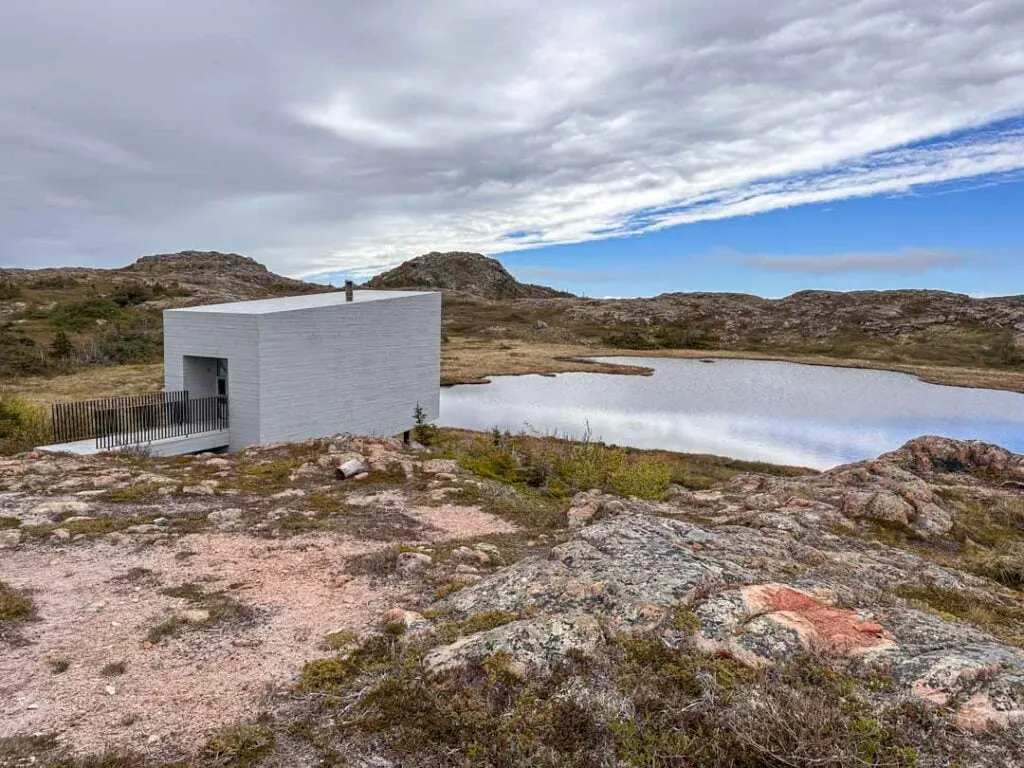
You can see some of the art produced at the studios if you visit the Fogo Island Gallery at the Fogo Island Inn. It is only accessible as part of a tour of the Inn.
I managed to visit three of the four studios on my visit. The studios are:
- Bridge Studio in Deep Bay
- Squish Studio in Tilting
- Long Studio in Joe Batt’s Arm
- Tower Studio in Shoal Bay
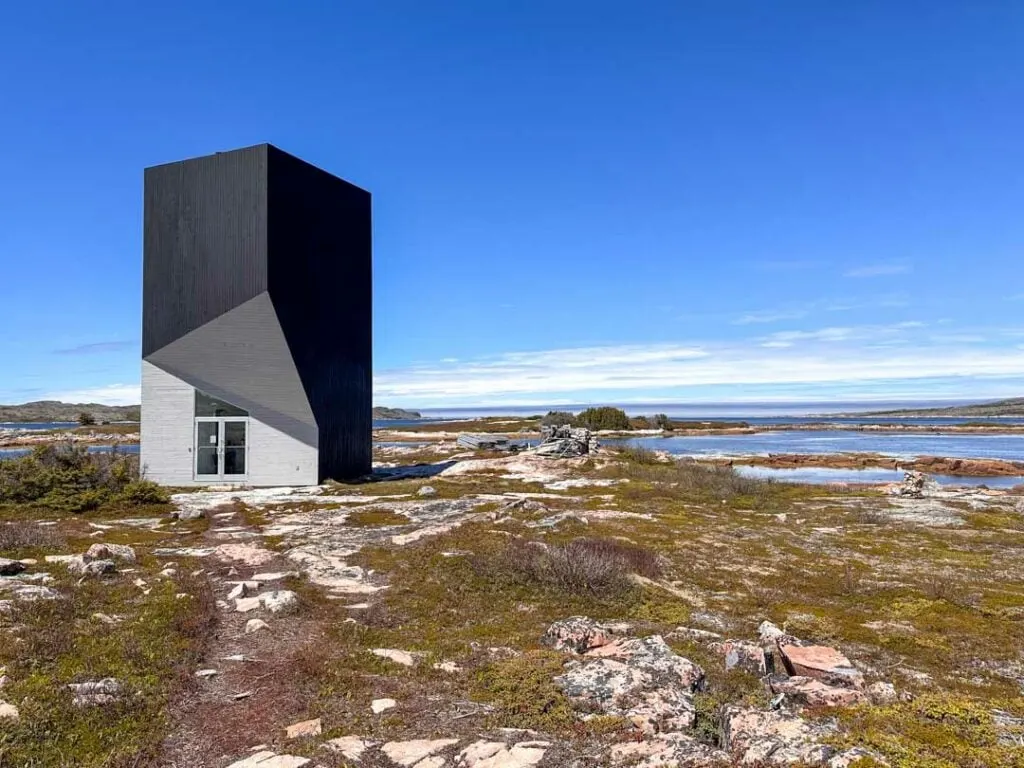
Visit the Towns
There are nine distinct towns spread out along the coastline of Fogo Island, each one with its own charm. Some have more to offer tourists than others, but I still recommend visiting as many as you can since they are all quite picturesque. I’ve got details on each one below.
Stag Harbour
Stag Harbour is just a few minutes from the ferry dock. The Fogo Island Visitor Centre is located at the entrance to Stag Harbour, but it was closed on my early June visit. This sleepy community is spread out along the edges of the long harbour. It’s a good spot for photos, but there aren’t any distinct points of interest here.
Seldom
The towns of Seldom and Little Seldom are located a few coves apart on the southern side of Fogo Island. In the Newfoundland tradition of whimsical town names, Seldom used to be called Seldom-Come-By. There are a few beautiful historic buildings here, including the Fogo Island Marine Interpretation Centre. (More on that in the museums section below.)

Deep Bay
Find Deep Bay on the west side of Fogo Island. The little community hugs the jagged coastline and rocky bluffs tower above. It was foggy when I visited, but that gave the whole area a unique moody vibe. You can follow the Deep Bay Trail, also called the Courting Trail, up to a lookout above the town. You’ll also find an artist’s studio at the end of this trail.

Island Harbour
The small community of Island Harbour sits at the end of a dead-end road. It has a good view of the Channel Islands and the ferry traffic. There isn’t much to see here besides picturesque fishing shacks.
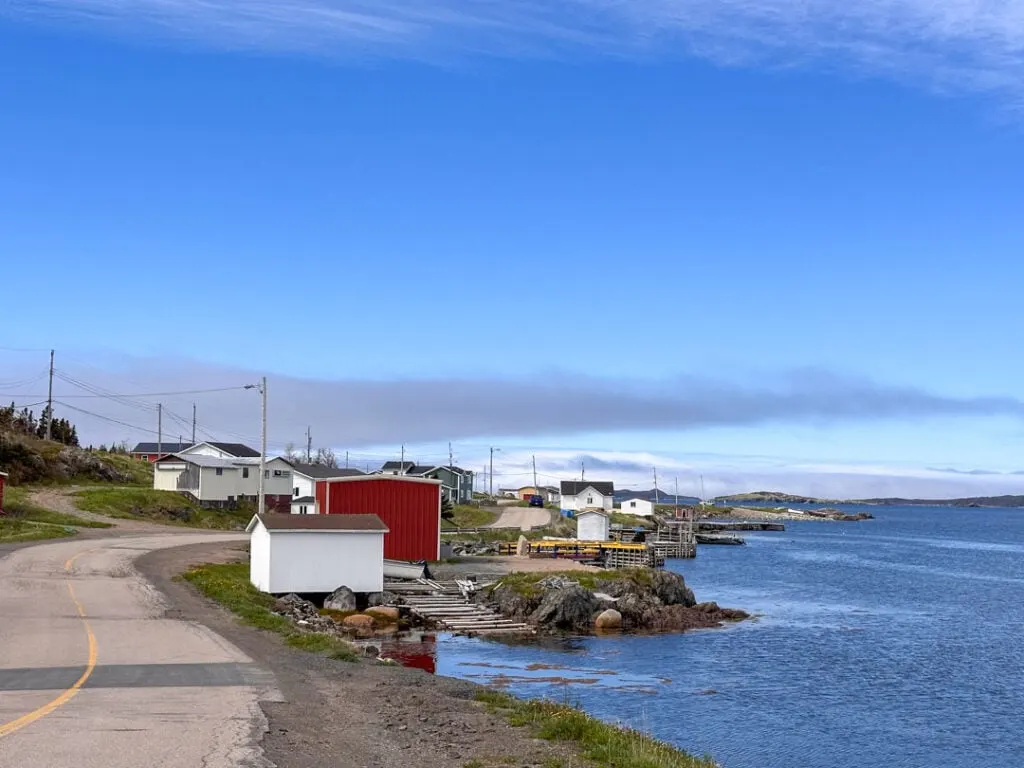
Fogo
The town of Fogo straddles a narrow channel between the main part of Fogo Island and Fogo Head. It’s by bar the largest community on the island and is where you’ll find most (but not all) of the shops, restaurants, and other services. It’s worth wandering around to look at churches, museums, and other historic buildings.

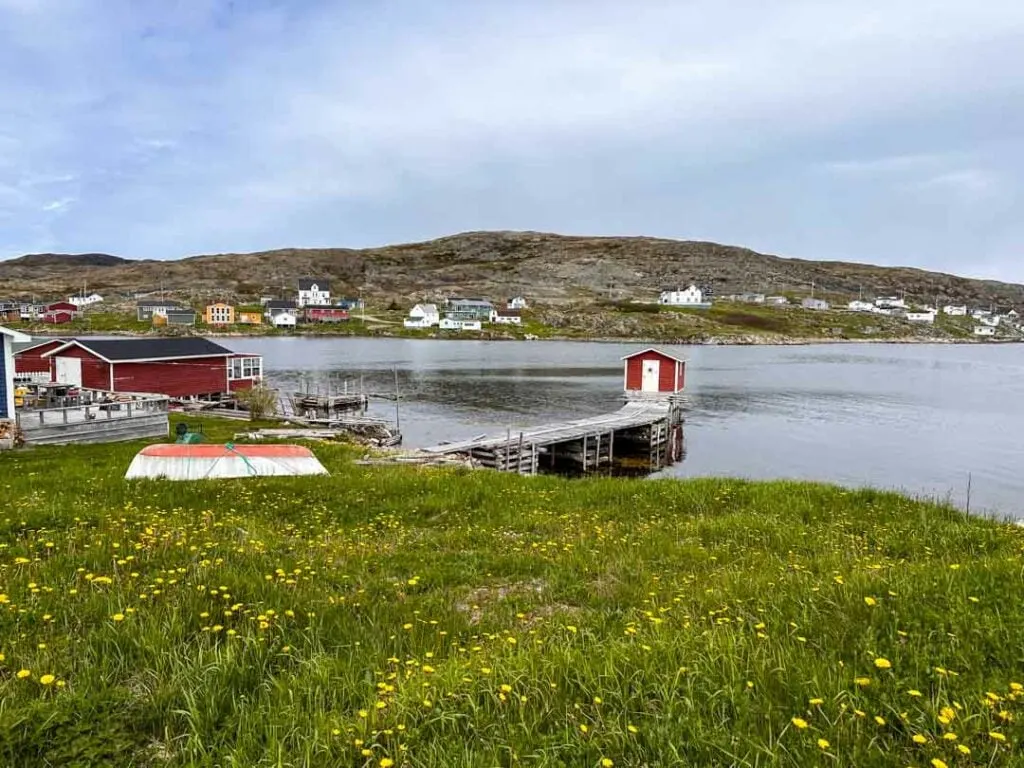
Be sure to venture over to Back Cove and Brimstone Head for great views. The lookout at the Fogo Battery the start of the Fogo Head Hiking Trail at the end of North Shore Road is also worth a visit. It has a great view of the harbour entrance.
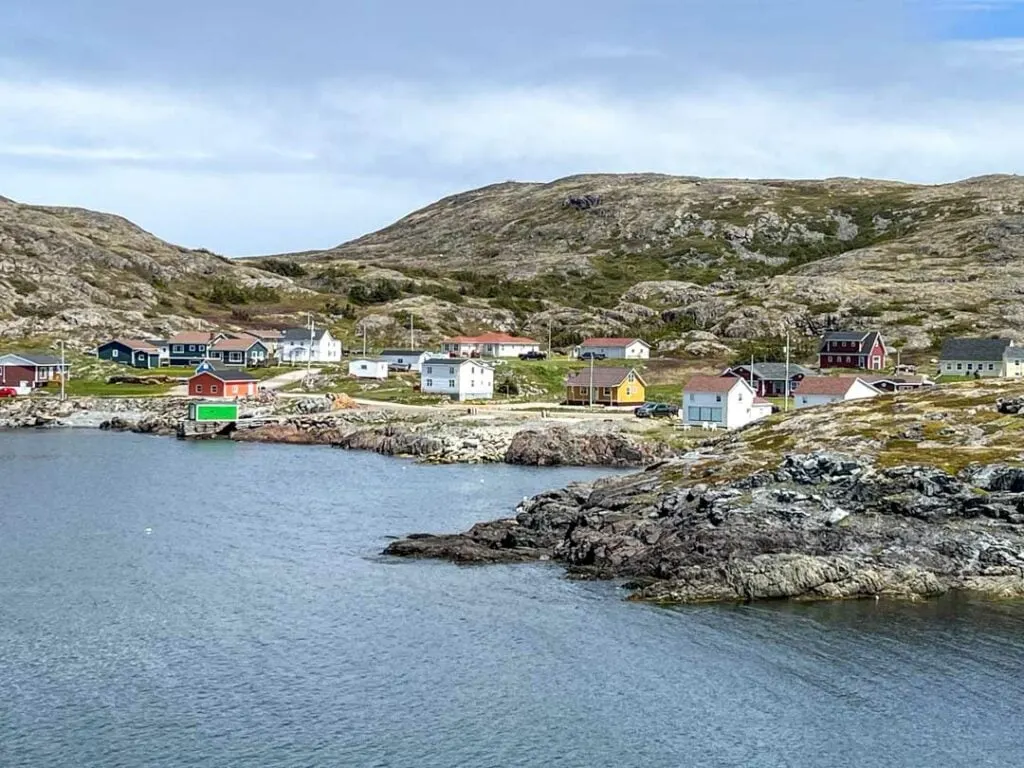
Shoal Bay
Shoal Bay is situated in the middle of the north shore of Fogo Island. It’s also the location of the only large grocery store, Food Land, on Fogo Island. The large bay has lots of rocky islets near the southern end, which you can see from the Shoal Bay Trail. This boardwalk path meanders through a marshy area and has an artist’s studio at the coastline.
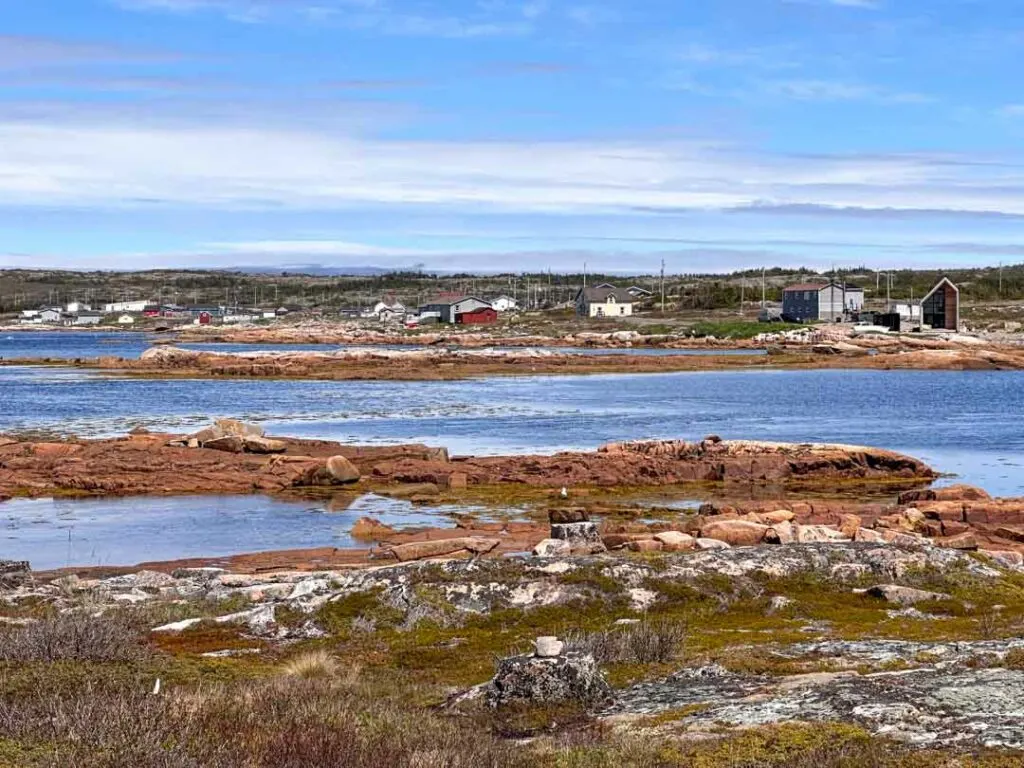
Barr’d Islands
The tiny community of Barr’d Islands seems to blend into the nearby town of Joe Batt’s Arm. However, before the road was built, it would have been quite isolated. Most of the town sits on tiny islands, connected with causeways. It’s the oldest settlement on Fogo and has some beautiful historic buildings.
Joe Batt’s Arm
Joe Batt was a sailor on Captain Cook’s ship. He jumped ship and settled on Fogo Island, giving the bay his name. Today the town is home to the Fogo Island Inn, as well as several museums and art studios. It’s also the starting point for the Joe Batt’s Point Trail which leads to a viewpoint at the Great Auk sculpture and has an artist’s studio part way along.
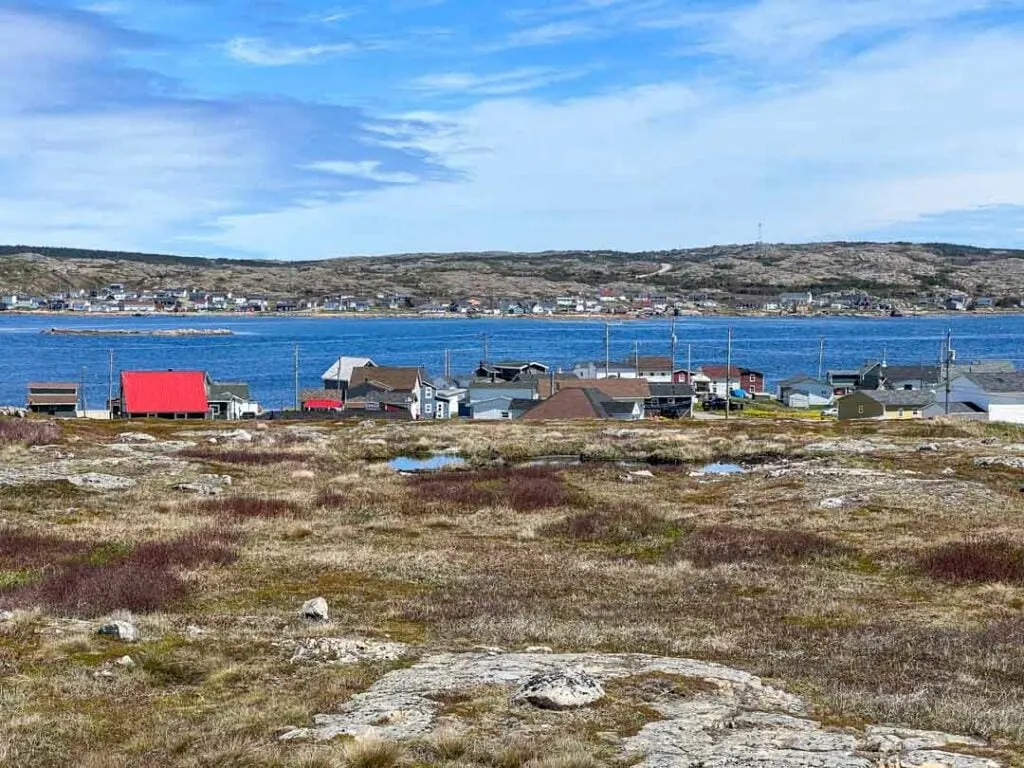
Tilting
As I said above, Tilting is known for its Irish history. In addition to the historical sites and museums, it also has a few hiking trails and a beautiful beach called Sandy Cove.

Hike Up Brimstone Head
This short 1.2 km round-trip hike takes less than an hour but it goes to a spectacular viewpoint on the top of Brimstone Head near the town of Fogo. After doing lots of hikes on Fogo, I thought it had the best effort-to-reward ratio and put it on my list of best hikes in Newfoundland.
The trail follows stairs and boardwalks to the top of a bluff where there is a great view of the ocean and the town of Fogo. You’ll gain 70 m as you climb to the top.
But Brimstone Head has another claim to fame – it is one of the four corners of the Earth according to the Canadian Flat Earth Society. (The society is mostly a joke meant to point out how even in the age of technology, people accept theories without using critical thought.)


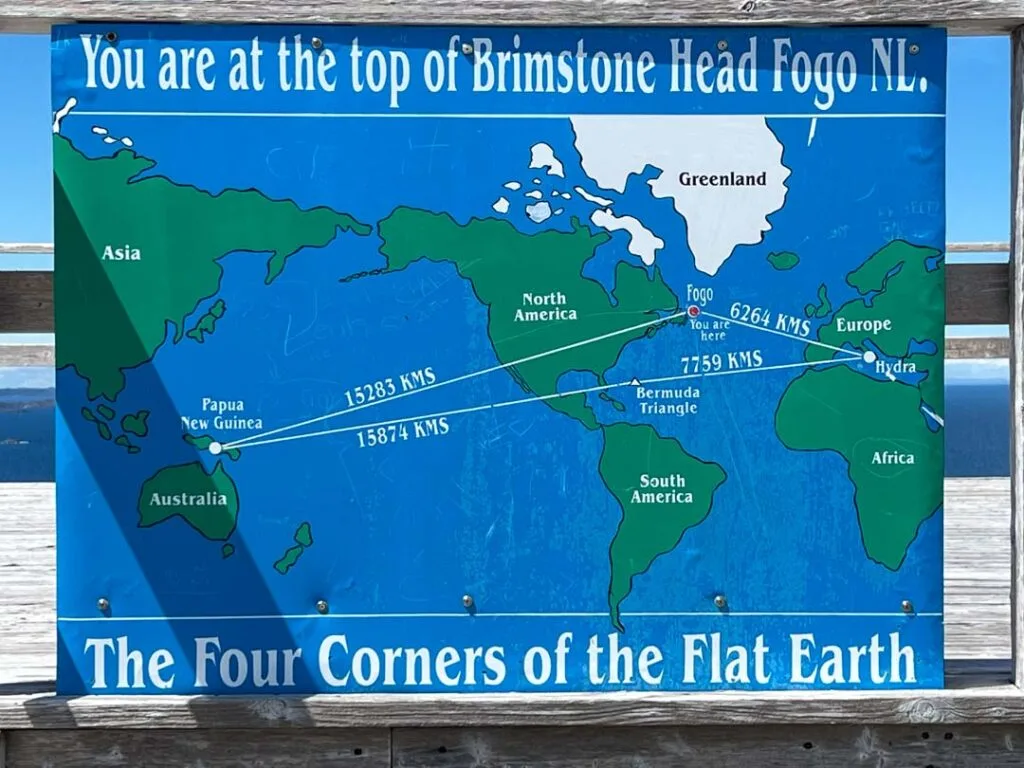
Other Hikes on Fogo Island
Even though I only spent two days on Fogo, I was still able to fit in lots of hikes. For the most point, the trails here are short, easy to moderate, and have great views. You can’t miss the hike up Brimstone Head (above), but I also recommend a few other hikes:
Deep Bay Lookout/Courting Trail
This short trail starts with lots of stairs as it leads up to a viewing platform overlooking the village. Keep going up the stairs and through the heath to a bluff 60 m above sea level. The Bridge Studio sits near a pond near the top. The hike is 1.6 km round-trip.

Shoal Bay Trail
The flat Shoal Bay Trail is almost entirely on a narrow boardwalk as it makes its way through a boggy area towards the coast and the Tower Studio. The hike is 1.2 km round-trip.

Joe Batt’s Point
This trail winds along the east coast of Joe Batt’s Arm out to Joe Batt’s Point. I didn’t have time to hike the whole thing, but I’ve heard there is a huge sculpture of a great auk at the end. Great auks are penguin-like seabirds that were hunted to extinction in 1852. The early part of the trail passes the Long Studio and has a great view of the Fogo Island Inn across the bay. It is a 5 km round-trip hike.


More Hikes
I wish I had more time to hike on Fogo. Here are a few hikes that I didn’t get a chance to try:
Fogo Head: A 2.1 km point-to-point head across the top of 103-metre-high Fogo Head. You can also make it into a 3.7 km loop by walking back to the start along North Shore Road. It has great views of the town of Fogo as well as Brimstone Head. There are lots of stairs and steep climbs on this one.
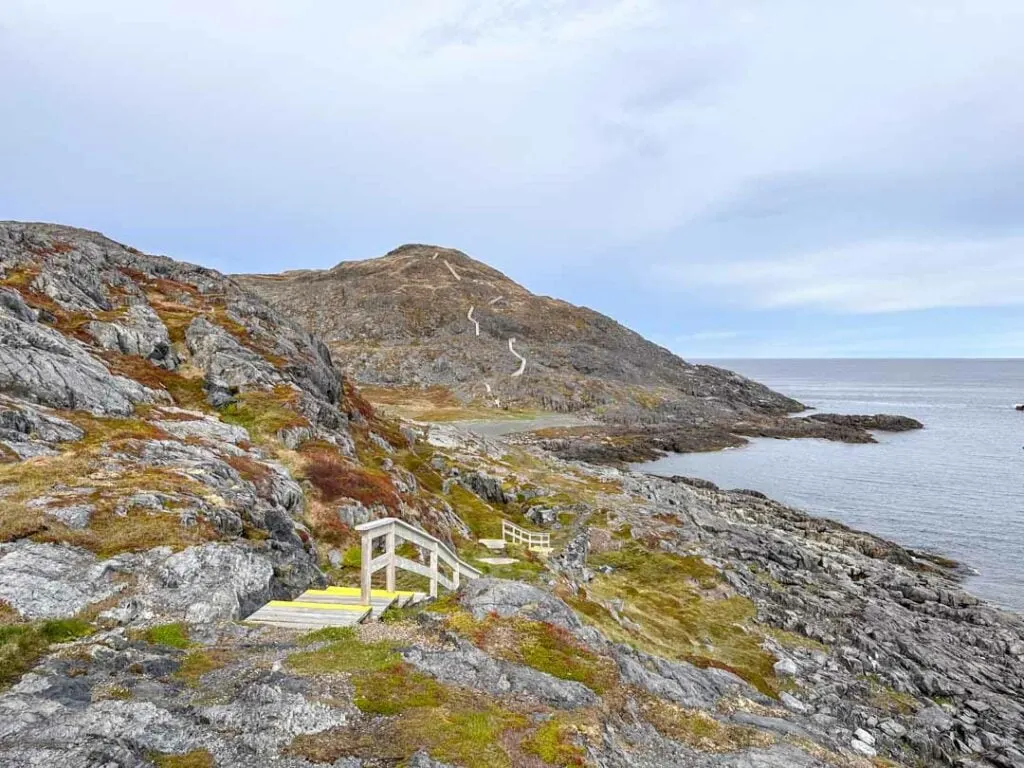
Lion’s Den: This 6.3 km loop trail on the east side of Fogo Harbour includes several viewpoints and interpretive signs about former communities. The trail climbs up to the top of a bluff, rambles along the coastline, and travels through marshes on boardwalks.
Turpin’s Trail: There are two parts to this trail – a 9.2 km round-trip eastern section and a 3.1 km round-trip western section. The trail starts in Tilting and leads along the coast past Squish Studio.
Oliver’s Cove: A 4.5 km loop trail in the southern part of Tilting. The trail leads along the coast and to a viewing platform.
Visit the Museums
When I visited Fogo Island in early June, most of the museums were not open for the season or were running on reduced hours, so I wasn’t able to visit any of them. (And if we’re being honest, I was too busy hiking anyway.) Most of these museums are open during the summer but hours can be erratic – just show up and see if they are open.
However, from my research, it looks like there are quite a few museums on the island that could be worth a visit. I’ve already mentioned some of the museums and historical sites in Tilting, but here are a few others:
Fogo Marine Interpretation Centre: This museum in Seldom tells the story of Fogo’s fishing past. It includes exhibits about fishing, the cod liver oil factory, and the unique history of fishing unions on Fogo.
Marconi Wireless Interpretation Centre: Find this museum in the northeastern part of the town of Fogo. It explains the important role of Fogo as a telegraph station.
Old School House Museum: This school house in the town of Fogo dates back to 1888 and has exhibits about Fogo’s history.
Experience Fogo: A museum in the western part of the town of Fogo with collections of old tools and other artifacts that demonstrate traditional life in Fogo.
Brett House Museum: A historical house in Joe Batt’s Arm that preserves a traditional house from the 1870s.
Bleak House Museum: A historical house on North Shore Road in the town of Fogo, Bleak House was the home of the region’s powerful merchants.
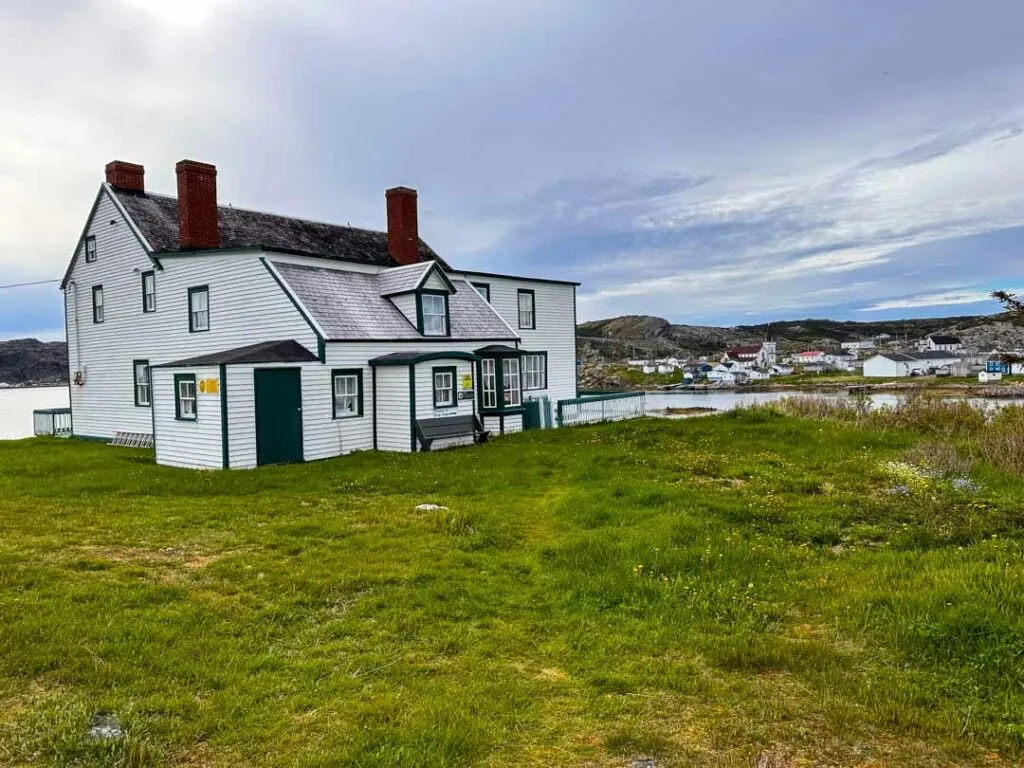
Browse the Galleries
Fogo has a thriving artist community. You can visit several galleries and workshops across the island. Most were not open on my visit and some are open by appointment only. The only one I managed to visit was the Fogo Island Gallery inside the Fogo Island Inn.
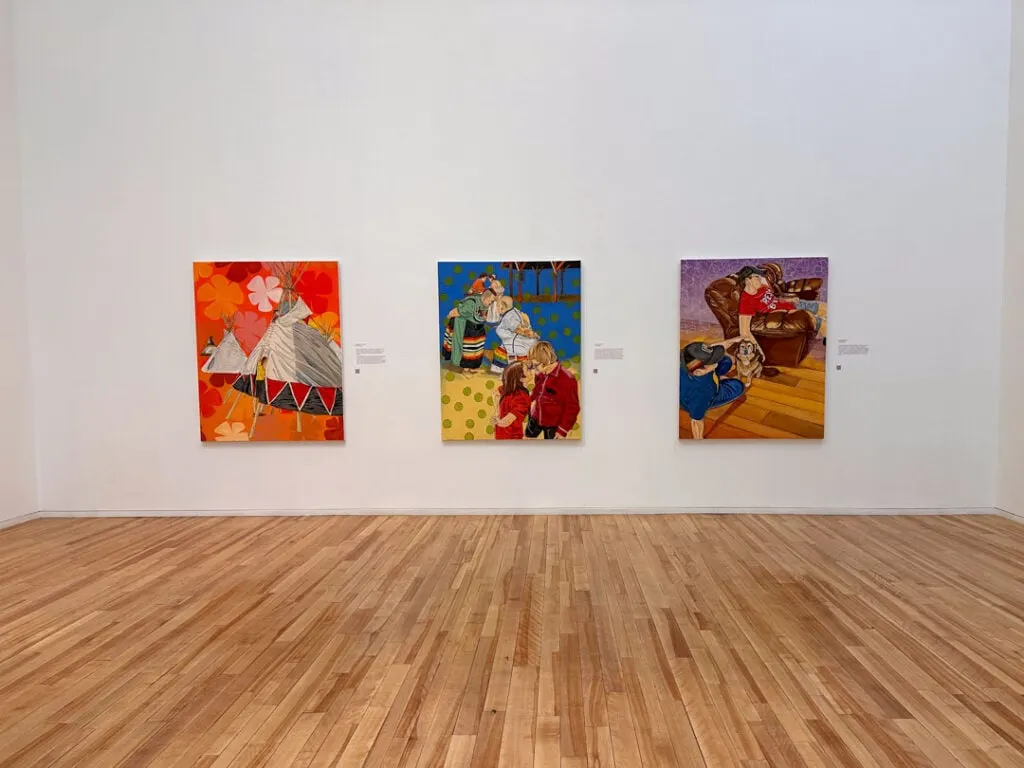
Other galleries and artisan workshops include Fogo Island Metalworks and Herring Cove Art Gallery, both in Shoal Bay; Young Studios and Mona’s Quilts in Joe Batts Arm; and Fogo Island Saltfire Pottery in Barr’d Islands.
Where to Eat on Fogo Island
For a small community, Fogo Island has a surprising number of restaurants and cafes. And many of them are really good!
Bangbelly Bistro: Run by ex-chefs from the Fogo Island Inn, this restaurant in the town of Fogo was by far the best restaurant I ate at in Newfoundland. I liked it so much, that I ate there twice. They serve unique, modern takes on traditional Newfoundland food. (The restaurant is named after a classic Newfoundland dessert that includes salt pork. Trust me – it’s delicious despite the inclusion of meat!)
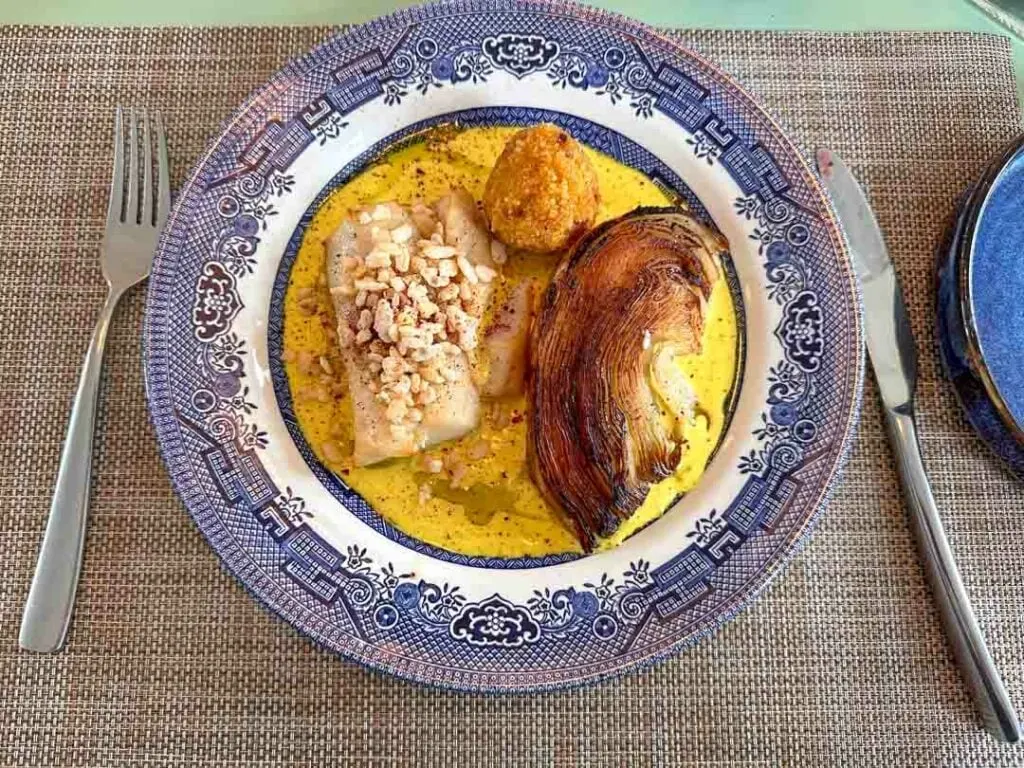
Punch Buggy: Owned by the same people as Bangbelly, this take-out spot in the town of Fogo has great coffee and breakfast sandwiches. They also make pizza.

Growler’s Ice Cream: This ice cream parlour in Joe Batt’s Arm has a line out of the door on sunny days. It’s run by the Shorefast Foundation.
Rock Bridge Cafe: A cute cafe in Tilting with baked goods, coffee, and soup. They also have lots of historical memorabilia on the walls.
The Storehouse: A restaurant in Joe Batt’s Arm specializing in locally sourced ingredients, run by the Shorefast Foundation. I didn’t have time to eat here, but I’ve heard good things.
Kwang Tung: Proof that hole-in-the-wall Chinese restaurants are in every small town in North America, although this is perhaps the most remote example. I didn’t eat here, but I did enjoy the chapter about this restaurant in Chop Suey Nation, Ann Hui’s excellent book about Chinese-Canadian restaurants.
Where to Stay on Fogo Island
From camping to all-inclusive luxury, the accommodation options on Fogo Island run the gamut. The number of lodging options is increasing, but there still aren’t that many choices. Reserve before you come.
Fogo Island Inn: If you want to splurge, this is the place. Impeccable service, incredible architecture, all-inclusive activities – it’s got it all. Check rates.
Old Salt Boxes: There are a few traditional Newfoundland fishermen’s houses that have been converted to vacation rentals. Mary’s Place in Fogo and the Family Cottage in Joe Batt’s Arm are good options. Check rates.
Peg’s Place: This cozy guesthouse in the town of Fogo is a popular choice. Check rates.
Brimstone Head RV Park: Waterfront campground next to Brimstone Head. We stayed here in our tent and loved the views. Check rates.
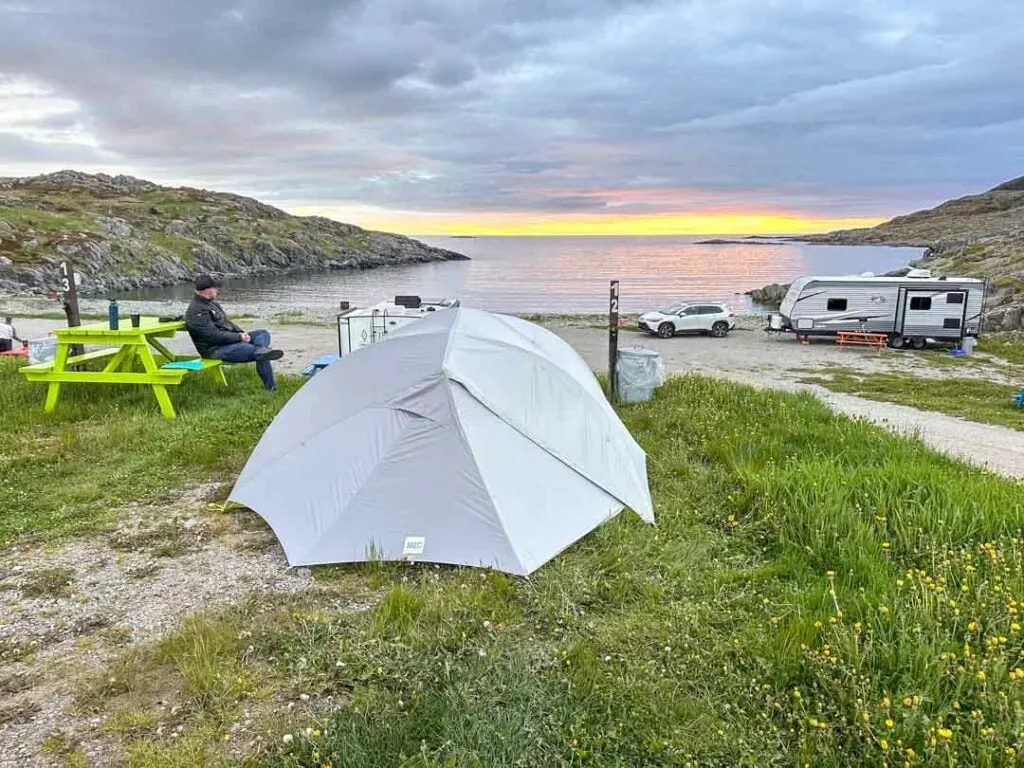
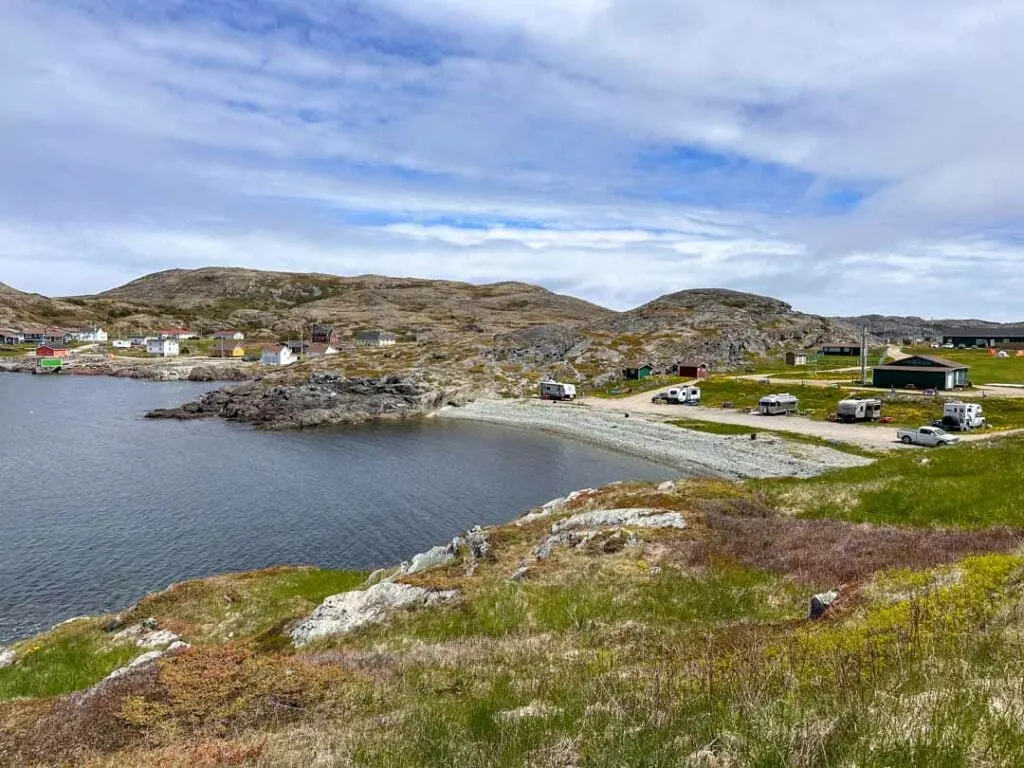
Final Thoughts
Fogo Island is one of my favourite places in Newfoundland and, to be honest, one of the most unique places I have ever visited. I wish I had spent more time there! While it may be a bit of a pain to get to, I think that’s what helps it feel so special.
If you’re planning a trip to Fogo and have questions, let me know in the comments – I’d love to help.
READ NEXT:
- 20 Incredible Things to Do in Newfoundland
- 10 Things To Do in Twillingate, Newfoundland
- 12 Things To Do in Trinity, Newfoundland
- 10 Things To Do in Bonavista, Newfoundland
- 18 Best Things to Do in St. John’s, Newfoundland
- Things to Do in Corner Brook, Newfoundland
- Things to Do in Gros Morne National Park
- 16 Best Hikes in Newfoundland
- The Best (and Worst) Backpacking Meals Reviewed - December 16, 2025
- My Favourite Hiking Gear of 2025 - December 9, 2025
- Best Insulated Skirts For Hiking and Snowshoeing in 2026 - December 5, 2025

